Why Invest in a Good Whole House Water Filter?
The straightforward yet crucial act of staying hydrated may be made safer using water filters. While drinking water straight from the faucet may be a practical approach to meet your daily need of eight glasses, it can also be contaminated with impurities like chlorine (how to test for chlorine in water?), microplastics, or heavy metals like lead, cadmium, mercury, and arsenic.
The greatest whole house water filters can get rid of these impurities, but they don’t work for everyone.
A variety of pollutants may be present in both well and municipal water. The incoming water can be filtered in a variety of ways, but for crystal-clear, filtered water as soon as it enters the house plumbing system, it may be preferable to employ a whole-house water filtration system.
You must first determine the composition of your water in order to select the best whole house water filter for you. If you have access to public drinking water, rules have been put in place to guarantee its cleanliness and safety. A house water quality test kit or the yearly water quality report from your neighborhood water provider are good places to start.
The greatest whole-house water filter might have one stage, two stages, or three stages, with the level of filtration improving with each step added. To lessen hard metals, these systems might additionally include water softeners. Softened water tastes salty? this could be why.
Consider the important factors outlined in the sections below as you look at some of the best goods available today.
Remember that whole house water filters differ not only in how they filter water, but also in how simple they are to install and how much they cost. Your unique demands will determine which sort of whole house water filter (such as a faucet filter, a water bottle filter, or a whole-house filter) is appropriate for you.
We assessed filters by kinds, filtering techniques, third-party certifications, pollutants eliminated, price, and usability while speaking with certified dietitians.
These are the top whole house water filters that can be found online.
Best Whole House Water Filter Systems
SpringWell CF
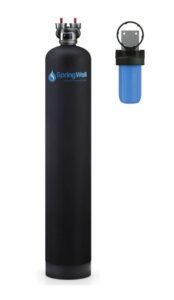
Because it can remove chlorine and provide water that tastes like it just came from a natural spring, the Springwell CF+ Whole House System is the greatest whole-house water system for your house.
There are several factors that make the SpringWell CF1 whole house filtration system our top pick. Its four-stage filtration system guarantees that you’re only using the cleanest water possible while drinking, bathing, and cleaning food, and its effects are felt almost instantly. My veggies taste better, my skin felt smoother, and my water no longer had the August city pool’s chlorine odor.
In addition, it is a high-quality product that is reasonably priced. The production rate of 1 million gallons of water per day was sufficient for our three-bathroom house (with extra capacity up to 7 bathrooms).
This unit’s capacity to filter water for up to nine months before requiring a filter replacement is one of its greatest features. Most systems need a filter replacement every three months, which over time adds up.
Features
- Broad contaminant removal – The SpringWell CF improves water quality and almost entirely removes chlorine, chloramine, heavy metals, PFOS and PFOAs, herbicides, pesticides, and more using certified KDF and catalytic carbon coconut shell filtration media.
- A sediment filter, KDF filtration media, coconut shell carbon media, and a final stage that prevents channeling while still allowing the water ample contact time with the filters, make up this whole house water filter system’s four stages of comprehensive filtration.
- Possibility of DIY installation – You can install the SpringWell whole-house water filter system yourself if you are experienced with plumbing.
- Six-month money-back promise The SpringWell may be purchased without danger since you have six months to return it if it isn’t the correct product for you.
- Three sizes – The SpringWell CF is available in three sizes: one for 1-3 bathrooms, one for 4-6 bathrooms, and one for 7+ bathrooms, so flow rate is not a concern.
Pros
- The best system for city use
- Tested and trusted
- Requires low maintenance
- Produces noticeably clear water
- NSF certified, USA made components
- 6-month money-back guarantee and lifetime warranty.
Cons
- Plastic fittings.
- Cartridge sediment filter will need to be replaced frequently (every 6 to 9 months).
- Not all parts for installation are included and will need to be purchased separately.
SpringWell WS
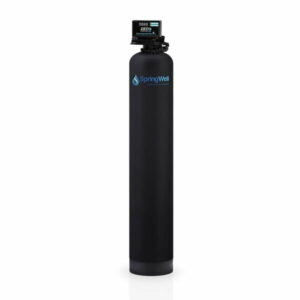
The whole house filter system needed to filter well water is more robust than the system needed to filter municipal city water. In this instance, the SpringWell WS’s capacity to filter out a variety of dangerous chemicals from well water pleased us.
Harmful contaminants like hydrogen sulfide, iron, and other pollutants thrive in private wells, but the SpringWell WS’s four-stage filtering system is able to handle all of that.
The Springwell WS is an Air Injection Oxidizing Filter System that employs a bed of green sand fusion to filter water as opposed to a KDF, which is the primary distinction between it and the SpringWell CF1.
The green sand fusion backwashes all impurities out of the bed using an Empress Vortech Tank, while the pocket of air oxidizes hydrogen sulfide, iron, and manganese.
Another advantage we found handy for the Springwell WS is its simplicity of installation and use. It is simple to operate the system and modify settings like the control valve and water use because it comes with a Smartphone app and built-in Bluetooth.
Components that have received NSF certification are used to create the SpringWell WS. Although all tanks and valves come with a lifetime warranty, they only provide a six-month money-back guarantee.
Despite the high initial cost of the system, the single tank design results in reduced maintenance expenses.
Key Features:
- Greensand medium, an air induction oxidation filter, a sediment filter, and an automated backwash stage make up the WS’s four comprehensive filtering stages.
- There are two sizes available, so flow rate shouldn’t ever be an issue. The system sizes are 1-4 bathrooms and 4+ bathrooms.
- Automatic backwash – You can set and forget the automatic backwash cycle thanks to the electronic control valve.
- The SpringWell WS requires almost minimal maintenance because it doesn’t utilize cartridge filters and doesn’t require chemical top-ups. The sediment filter only has to be replaced every 6 to 9 months.
- One of the few manufacturers that provide a free installation kit that contains everything you need to install the system is SpringWell.
Pros
- Suitable for well water.
- Improves orange and black staining problems.
- Eliminates rotten egg sulfur smell.
- No maintenance required.
- No drop in water pressure.
- Well water test kit add-on available.
- Bluetooth app connection.
Cons
- Expensive initial investment.
- Plastic fittings.
SoftPro Whole House Upflow Carbon Filter
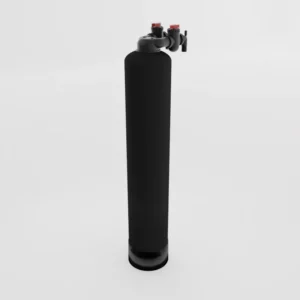
When used in conjunction with a water softener, the SoftPro Carbon is an economical whole house water filtering system that can perform on par with the other items on our list. The Softpro Catalytic Carbon Filter is less expensive but still provides a flow rate that is worth its cost.
Be not startled by its low cost; this does not at all suggest a lower level of quality or filtering technology. Instead, the SoftPro Carbon, like SpringWell systems, features an upflow design that removes impurities more effectively than typical downflow filter systems.
The SoftPro system filters water using an innovative catalytic carbon medium, which is cleaned by a chemical-free and catalytic backwash. The SoftPro Carbon is constructed of copper and zinc and eliminates dissolved impurities in water by using oxidation and reduction. This includes chloramines, heavy metals, pesticides, herbicides, and chlorine.
The water supply’s chlorine was successfully removed by this whole-house water filtering system while storage space was increased. It’s an added plus that it doesn’t need power to work well, which was a welcome surprise.
Additionally, the SoftPro Carbon can filter water at high flow rates while generating little effluent. Additionally, its filter has a six-year lifespan and can produce 1,000,000 gallons of water during that time. As a result, it ranks as one of the most reliable and affordable choices in this list.
However, it has several limitations, such as the inability to remove fluoride or total dissolved solids. However, it’s a respectable choice for individuals who want water that is comparatively nutritious, tasteless, and devoid of odor.
Another significant drawback of this whole house water filter system was that it actually increased the hardness of my water, which made lathering in the shower difficult and increased the expense of purchasing an extra softener.
Key Features:
- Strong contaminant removal: The Evo E-1000 Whole House Water Filter’s two combined filters outperform media-based systems in their ability to filter out impurities including chlorine, chloramine, dirt, debris, rust, and more.
- The system’s washable and reusable sediment pre-filter allows you to save money in the long term by preventing the need to replace filters that aren’t essential.
- Blocks of catalytic carbon – The Evo E-1000 Whole House Water Filter utilizes catalytic carbon media, one of the most efficient and often used media in whole house systems, which is capable of eliminating chloramine, certain heavy metals, PFAs, pesticides, and other contaminants.
- 80,000 gallons of life – This whole-house water filter system uses cartridges that may last up to 80,000 gallons.
Pros
- Inexpensive and cost-effective
- Highly efficient at removing contaminants
- Very high storage capacity
- Easy maintenance
- Requires no electricity to run
- Two system sizes.
Cons
- Not suitable for well water
- Additional water softener might be necessary
- No evidence of NSF certification
US Water Systems Matrixx Infusion Iron and Sulfur Removal System
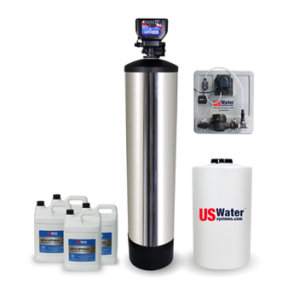
One of the top manufacturers of commercial-grade filtering systems is USWS. They have a Matrixx whole-house water filter system as proof of that.
Because the Matrixx is a whole house water filter and softener combo system, we really enjoy it. Additionally, it has a combination softener/eradicator for iron and sulfur to make your water softer and taste better.
It eliminates the rotten egg odor that emanates from faucets in addition to giving cleaner drinking water. Softer water is used to wash both clothing and appliances.
Starting the filtering procedure by oxidizing all the iron and sulfur in your water is a hydrogen peroxide injection panel in the incoming water line. Next comes a catalytic carbon block filter made of coconut shells, which removes harmful compounds like iron, sulfur, and manganese.
A Magna filter that eliminates particles like silt and sand strengthens the filtration process further. The water softener follows. The rate of water waste is decreased and all remnants from the filter media are removed by an automated backwash.
Additionally, no technical assistance is required to put it up. The straightforward and well-organized instruction booklet makes installation a snap. Additionally, it incorporates Bluetooth-enabled smart valves that let users monitor and manage the filtering and softening operations.
Despite being somewhat more expensive than our top pick for a well water filter, the SpringWell WS, the USWS Matrixx is a respectable second-place option.
The fact that the water volume wasn’t indicated is a drawback. Although we have trouble finding this information online, contacting customer service could be helpful.
Key Features:
- Four thorough filtration stages – The Matrixx Infusion uses chemical injection and oxidation to remove iron and sulfur. The process is broken down into four stages: hydrogen peroxide is injected into the water, minerals are oxidized, minerals are filtered out of the water by a coconut shell catalytic activated carbon media, and automatic backwashing removes the oxidized minerals.
- Simple to set up and operate – Programming the WaterLogix technology and getting the system ready to use takes less than 30 seconds.
- Excellent filter backwashing – The Matrixx Infusion’s superior backwashing feature allows the catalytic carbon media to survive up to 5 years.
- Operating the filter efficiently allows you to use 30% less water and save money because of the whirling Vortex backwashing technology.
Pros
- Adjustable sizes,
- Pre-oxidation process
- Backwash feature to remove contaminants from filter media
- Filter media lasts up to 5 years before it needs replacing.
- Easy to clean and install
- Free app to track water usage
- At least a 5-year warranty on all features
- full 7-year warranty.
Cons
- This unit uses hydrogen peroxide, which will need replenishing frequently
- No natural iron or sulfur removal process.
- Related expenses run high
- Not as reliable as the SpringWell WS
- Not as effective on hard water
US Water Systems BodyGuard Plus
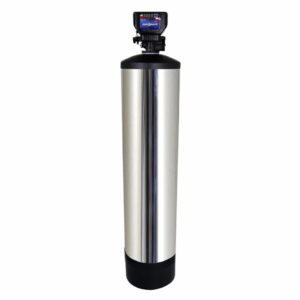
Because the carbon filter in the BodyGuard Plus Whole House Water Treatment System may last up to five years before needing to be replaced, it gets the fourth place.
The system itself is incredibly streamlined, and because it is done in two stages, there aren’t many parts to install and it blends in really nicely. It performed an excellent job of removing a significant amount of chlorine from my water source.
If I’m being honest, it was a bit of a bummer that I had to spend $200 more to make the Bodyguard Plus a two-stage system. A main sediment filter shouldn’t need to be added on, in my opinion. One of the main factors that contributed to this whole house water filter system placing fourth was the absence of a pre-filter.
I didn’t like the fact that the new cartridge would cost over $900 even though it would be another five years before I needed to buy one. Yikes.
I would choose the Springwell CF+ Filter System over the US Water Systems BodyGuard Plus because of how expensive it seems to get over time.
Key Features:
- New and enhanced design – The Bodyguard Plus filtration system is made to perform harder and longer since it contains 35% more media than the original Bodyguard filtration system.
- Removes a wide range of pollutants – This single-tank filtration system can get rid of bacteria, viruses, cysts, lead, heavy metals, chromium 6, pesticides, chloramine, and chemicals.
- Performance that is efficient – Using backwashing and smart valve technology, this whole house softener is made to use as little water as possible, cutting down on water waste.
- Designing effective filter media Catalytic carbon and granular activated carbon (GAC), two well-liked substances that have constantly demonstrated their efficacy at water filtering, make up the resin in the Bodyguard Plus. Additionally, a 5-micron sediment filter serves as a pre-filter and helps safeguard the system.
Pros
- Removes harmful contaminants but retains healthy minerals to improve the overall taste of water.
- Smart valve technology reduces water waste, only backwashing when absolutely necessary
- Clear installation instructions.
- Available in three sizes to fit what’s right for your house.
- Valves and electronics have a 10-year warranty, while the media has a 5-year warranty.
Cons
- Despite clear instructions, the installation process is still complex.
- Expensive pre-filtration systems
House Master
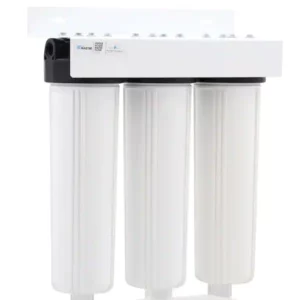
This system is quite affordable, and installation is also very simple.
For those searching for a cheap whole-house filter, the house Master HMF3SdgFeC Whole House Filtration System is a reliable option for removing silt and total dissolved solids.
You always get what you pay for in life, and while this unit does a decent job of purifying the water supply in your house, I’m not sure how long it will last until it breaks due to the cheaper plastic feel.
The CF+ is by far the superior product, and based on what I experienced and observed with the house Master, it won’t be long before you’re placing phone orders for new components with customer service.
Key Features:
- The house Master HMF3SdgFeC effectively and affordably eliminates a variety of pollutants from water, including lead, sediment, VOCs, iron, and herbicides.
- Large-sized fittings and filters – The house Master system’s bigger fittings and filters ensure that your water pressure won’t decrease as you use it.
- Long-lasting filters — Since the filters last between 6 and 12 months, maintenance isn’t required too frequently.
- Install-and-forget architecture You can easily install the system and replace the filters as needed because there is no control head to handle regenerations, or backwashing, to schedule.
Pros
- Easy installation for those with basic DIY skills.
- System targets a broad range of contaminants, including VOCs and herbicides.
- Filters last a long time. Carbon filters last for up to 95,000 gallons or around 6 months, while the sediment and iron filters last for 9–12 months.
- The House Master is backed by a 2-year warranty.
Cons
- Requires more maintenance.
- Few extra parts will need to be purchased for installation
- Only removes up to 3 PPM of iron, so it’s not as effective as other well water iron filters.
Aquasana Rhino
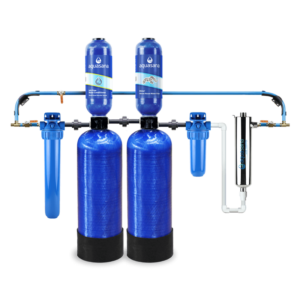
In comparison to the Springwell CF1 whole house water filter system for municipal city water, the Aquasana Rhino is a deserving runner-up. In addition to removing up to 97% of the chlorine from municipal water, it significantly lowers the levels of VOCs, mercury, lead, herbicides, and pesticides. Additionally, it will function for at least ten years thanks to its 1,000,000 gallon capacity.
An unusual upflow twin tank powers this system. With whole house water filter media, clogging or channeling is a typical issue that the tank attempts to avoid.
Bacteriostatic material is added to the filtering process to safeguard your water supply and increase the filter’s lifespan. It stops bacteria and algae from proliferating within the system and damaging the filter.
The Aquasana Rhino’s ease of repair is one feature we particularly appreciate. Even though maintenance is seldom necessary, when it is, the procedure is easy and pleasant. The Aquasana website’s PDF version of the owner’s handbook is fairly simple to read. The requirement for expert installation in order for the guarantee to be effective is the only genuine drawback.
Even while the Aquasana Rhino whole house water filter system initially costs a lot, its eventual advantages greatly surpass this. You may simply add-on a salt-free water conditioner or a UV filter as well, with a slight increase in cost, if you’re interested in boosting the filter’s effectiveness.
Pros
- Add-ons available for salt-free conditioner, UV filter, and pro-grade install kit
- Independently-tested system
- Removes up to 97% of chlorine present in water
- Improves your house’s air quality
- 10-year filter life and 10-year limited warranty
Cons
- Can become expensive (If you include add-ons)
- Professional installation required for warranty
Culligan Whole House Heavy Duty
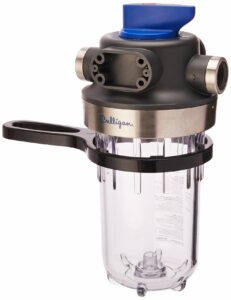
The 1-inch inlet and outlet ports on this whole-house filtration system allow you to attach it to 1-inch plumbing. Although the particular whole house water filter cartridge might affect the flow rate, the wide diameter of the water input and outflow helps avoid a drop in water pressure within the house. The highest flow rate of this device, which features a heavy-duty sediment filter to remove rust, sand, silt, and other debris from the water, is 10 GPM.
Depending on the water composition and plumbing system condition of the residence, the Culligan whole-house water filter system may also be used with 12 different Culligan filter cartridges to remove a variety of impurities. If a maximum flow rate of 4 GPM is acceptable, pick any of the six standard filter cartridge options, replacing the cartridges every three to four months.
The flow rate may be increased to a maximum of 10 GPM with any of the six heavy-duty filter cartridge choices, and they can last up to 6 months before they need to be changed. Besides being known for producing great whole house water filters, how much do Culligan Water Softeners cost?
Pros
- Heavy-duty sediment filter with a 10 GPM maximum flow rate is provided.
- Compatible with 12 different Culligan cartridges to accommodate plumbing system and water composition demands.
- Cartridges last about three to six months (depending upon selected cartridge)
- Reasonable pricing range
Cons
- Installation may be complicated.
Buyer’s Guide for the Best Whole House Water Filtration System
Take the time to carefully analyze a few key criteria before selecting a filtering system, such as the kind of impurities, flow rate, and installation necessities. It is simpler to choose which whole-house water filtration choice would be the finest for your house if you are aware of these aspects.
Types of Whole House Water Filters
Whole house water filter systems come in a variety of varieties today:
Single Tank Systems
Whole-house water filters with a single tank each include a filtering medium. These systems often employ carbon, KDF, or a mix of media types to target various pollutants such chlorine, chloramine, PFAS, pesticides, and THMs.
To safeguard the media, most single tank systems come with a sediment pre-filter. The media should last between six months and six years, depending on the system you choose, before it has to be replaced.
The majority of single tank whole house filters may be put both inside and outside thanks to their stainless steel tank designs.
Cartridge Filters
These whole house water filters employ a replacement cartridge to get rid of impurities as little as.04 microns and as large as 500 microns. Sediment filters, heavy metal filters, organic chemical filters, and others can be found in cartridges.
The user may select the optimum cartridge to use in the filter based on the demands of the house, and the cartridge has to be replaced once every three months to a year.
A granular activated carbon filter, which may remove a variety of contaminants including chlorine, heavy metals, pesticides, and herbicides, is typically part of cartridge filter systems. A carbon block filter and a sediment filter are frequently included in a cartridge whole house water filtration system.
1-stage whole-house water filters feature a sediment filter cartridge in the tank. These are the simplest whole-house water filter systems available, however they may be combined with a water softener to help lessen the amount of heavy metals in the water.
2-stage whole-house water filters feature two filtering tanks. Depending on the type of filter cartridge used in each tank, the pollutants removed from the water will vary, but typically these systems are designed to remove sediment, chlorine, dirt, sand, and rust.
3-stage whole-house water filter tanks can each be fitted with a different type of filter to remove organic matter, pesticides, chlorine, unnatural tastes, odors, heavy metals, algae, microorganisms, iron, lead, dirt, sand, rust, and other contaminants from 3-stage whole-house water filters, which require a lot of space to set up. These are the cartridge filters’ best available choices.
Whole House Reverse Osmosis Systems
A reverse osmosis water filter system is another common choice for whole-house water filtration. This filter can remove 99.9% (or more) TDS from both well water and municipal water, as well as heavy metals, microorganisms, and pollutants. If you’re searching for a more complete pollutant removal solution, you could require a whole house RO water filtration system.
The most effective at eliminating the widest variety of impurities from water, RO filters are more expensive than other whole-house water filter options and can be more expensive to maintain. While ordinary carbon filters cost a few hundred dollars, RO filters for the house can cost as much as $3,000 to $6,000, depending on the model’s sophistication.
For every gallon of filtered water generated by traditional reverse osmosis systems, around 4 gallons of water are wasted, but modern versions are more efficient and waste just 1-2 gallons of water every gallon of refined water produced. Additionally, RO removes beneficial minerals from a water source.
This kind of filter can remove particles as fine as 0.0001 microns and is more effective than a cartridge system. These processes provide clean, filtered water by removing all organic molecules, viruses, and the majority of minerals. Reverse osmosis whole-house water filters cost a lot to install and maintain, though.
These systems aren’t very common and might be hard to get without going straight to a provider because of the high prices. Reverse osmosis water filters for single faucets are an exception since they are more widely used and more reasonably priced.
Ultraviolet Disinfection (UV)
UV filters employ ultraviolet radiation to harm the DNA of bacteria, viruses, and protozoa that are aquatic pathogens. These filters can be used alone to purify water or in conjunction with cartridge or tank filters to filter out a wider variety of impurities.
Only living germs can be eliminated from water by a UV filter. By eliminating hazardous bacteria, this kind of whole-house water filtration system can disinfect water, but it won’t enhance the flavor or quality of the water.
If you use well water or have any other reason to be worried about microbiological contamination, you should take into consideration the UV filtering that some whole house filtration systems provide as an optional add-on.
Is a Whole House Water Filter Necessary?
Whether you install a whole-house water filter system is entirely up to you. The easiest approach to be safe is to filter your water at house because hazardous pollutants may be found in most tap water systems.
If a whole-house water filter is required in your house, you may test your water to find out. A whole house water filter can enhance your water quality and make it safe to drink if your test reveals one of the following things (or if you personally see these things):
- Your water has a lot of contaminants in it.
- You have chlorinated water.
- Your water is murky or contains floatable particles.
- Your water has an odd flavor or odor.
A whole-house water filter’s primary function is to filter out a variety of impurities from drinking water, improving its flavor and making it safer to consume. Using a whole-house water filtration system is the best course of action if you want to enhance the quality of your water.
What To Consider When Choosing The Best Whole House Water Filter
Water Supply
The pollutants you deal with and the best sort of whole house water filtration system for you depend on whether you acquire your water from a municipal or well source.
The majority of whole-house filters are made for municipal water systems and can get rid of lead, chlorine, and other typical toxins found in city water. To identify the impurities that a filter is needed to eliminate, test your water source beforehand.
A well water filtration system is a preferable option if you acquire your water from a private well.
Types of Contaminants
Both well water and city water can include a range of impurities that can impact the incoming water supply. Disinfectants, sediment, bacteria, heavy metals, and organic compounds are examples of typical pollutants. Systems for whole-house water filtration are available in one, two, or three stages.
In order to enhance water quality and ensure that it is safe for use, 3-stage filtration systems will eliminate the majority of impurities. However, it’s a good idea to check the Environmental Working Group’s National Drinking Water Database to see what impurities could be impacting your water. The following is a thorough list of potential contaminants:
Benzene, 1,2,3-trichloropropane, 1,4-dioxane, estrogen, silt, bacteria, viruses, parasites, iron, lead, nitrates, nitrites, arsenic, antimony, cadmium, chromium, copper, lead, selenium, pesticides, herbicides, and insecticides are just a few of the contaminants that may be found in water.
Water Flow Rate
The most water that can travel through a whole-house water filter in a specific length of time depends on the water flow rate of the filter. Usually, this is expressed in gallons per minute, or GPM. Large appliances like showers and dishwashers, which typically require a flow rate of roughly 5 GPM, require a whole-house water filter to have a water flow rate high enough to effectively feed them.
Most whole-house water filter systems have high water flow rates, ranging from 10 to 25 GPM, to assist meet the demands of the entire house, however some systems have lower flow rates and some have higher ones.
Water Consumption & Filter Capacity
The volume of filtered water that a filter can generate over the course of its lifetime is referred to as its capacity. You will be able to use filtered drinking water from a private well or a city water supply faster and more effectively the larger the whole house water filter capacity of the system.
Standard water filters, such as carbon-based filters, offer greater filtering capacity and don’t waste any water. This approach to water filtration doesn’t flush water away as it works. The caliber of a filter and the components that make it up determine its capacity.
The quality of the product and the manufacturer are often what determine how long a filter will last. Some types of water filters could last longer than others.
Pre-sediment water filters often have the shortest lifespans due to their rapid clogging by big particles. Pre-sediment filters typically need to be changed every three to six months.
Depending on how often they are used, carbon filters and remineralization filters (which add beneficial minerals to water) last anywhere from six months to a year on average.
Up to two years might pass before a RO membrane has to be replaced.
To find out when a product’s filters need to be changed, do some research. The best whole-house water filter systems vary in how many filters they include. No matter the type you choose, you’ll need to routinely replace your filters if you want to get the most out of your system because they don’t last forever.
Contaminant Reduction Capability
Different whole-house filters remove different types of pollutants. Most will focus on lead and chlorine, but some systems can get rid of hundreds of pollutants, while others can only get rid of ten.
Before selecting a whole house water filter based on its ability to reduce contaminants, you must be aware of the composition of your water source. I advise you to ask your community’s tap water supplier for a report on the water quality in your neighborhood. You may learn more about the many components of your drinking water from this. Using a water test kit on your own water is another approach to determine the quality of the water.
Knowing what’s in your tap water will help you decide what has to be removed.
System Footprint & Space Available
You’ll need to put your house water system somewhere, which calls for having room to connect a whole-house water filter to your main water line.
Not only will you need room to keep your water filter, but you’ll also need access to the device so you can replace filters or maintain the system.
Sediment Pre-Filter Micron Rating
A micron is one millionth of a meter in length and is used as a unit of measurement. We can’t truly see anything smaller than 40 microns, thus microns are quite little.
The effectiveness of a filter to remove impurities depends on the micron size of the particles. So, for instance, a sediment filter with a 5-micron mesh size may filter out particles as fine as 5 microns, while a 1 mm mesh size can filter out particles as small as 1 micron.
A filter’s nominal micron rating measures its capacity to filter out particular particle sizes with an efficiency range of 50% to 90%. Therefore, if a filter has a nominal micron rating of 5, it can remove particles at a 50% to 90% efficiency.
A filter’s absolute micron rating indicates whether it can remove particular particle sizes with an efficiency of at least 98.7%. This indicates that a filter is far more effective at removing a particle as small as 5 microns if it has an absolute micron rating of 5, and it will remove at least 98.7% of the particles from water.
The micron ratings of a certain filter should be listed in its product information. A micron filter’s grade will indicate the kinds of particles it will best remove because all particles are different sizes.
Because their filters are made to remove particles of various micron sizes, household water filtration systems with a greater choice of filters are frequently the greatest high-quality whole house water filter option for eliminating the most toxins from municipal and well water.
Installation and Maintenance
It’s more difficult to install a whole-house water filtration system than a faucet filter. The user will generally need to cut the water pipe and install a set of fittings suited for the filter, as well as turn off the water to the entire house, empty the lines, and shut off the water. If you don’t have prior plumbing skills, including the ability to cut and solder new plumbing fittings, it is recommended that you use a professional plumber or water filter installation firm to install the whole house water filter.
Depending on water use, water quality, and filter type, the filter cartridge has an average lifespan of 3 months to 1 year after installation. With the majority of whole-house water filters, changing the cartridge is simple. To remove the old cartridge, simply detach the filter tank(s), turn off the water, and empty the lines. Install a fresh cartridge, tighten the filter tank, then refuel the water system.
Certification to NSF/ANSI Standards
Search for certifications from NSF International, a private company committed to creating requirements for water filtration that are safe for the public. If they fulfill specific minimal standards, it grades water filters and awards them an American National Standards Institute (ANSI) certification.
- The largest certified organization for testing and certifying water to NSF/ANSI standards is the Water Quality Association (WQA). NSF/ANSI 42, 44, 53, 55, 58, 401, 244, and 231 are examples of common NSF/ANSI certification requirements.
- The least stringent NSF/ANSI certification is for 42 filters. Chlorine and big sedimentary particles that impact taste and odor are removed by these filters.
- In order to lessen the presence of barium, radium 226/228, and hard metals like calcium and magnesium, NSF/ANSI 44 filters have been developed and approved.
- Hazardous pollutants including lead, cryptosporidium, volatile organic compounds (VOCs), and chromium are eliminated by NSF/ANSI 53 filters.
- In order to destroy or eliminate bacteria, viruses, fungus, and other microbes that can be present in your water supply, NSF/ANSI 55 filters are commonly approved for UV filtration systems.
- Reverse osmosis systems use filters that meet NSF/ANSI 58 standards. This proves that total dissolved solids (TDS), cysts, barium, copper, arsenic, lead, and more are all removed throughout the filtering process.
- Prescription medications, novel herbicides, insecticides, flame retardants, and detergents are just a few of the developing substances that NSF/ANSI 401filters are approved to eliminate.
- Filters meeting NSF/ANSI 244 and 231 are designed to exclude microbiological pollutants. They are frequently used by campers and backpackers in isolated places where biological contamination is a frequent occurrence.
Softening Capability
The majority of devices come with sediment filter cartridges, which are cartridges designed to filter biological or chemical impurities, although some whole-house water filters can employ heavy metal cartridges to minimize the amount of calcium, magnesium, and other minerals. A whole-house water filter and softener combo is recommended if your house has hard water problems.
This guarantees adequate filtration of the water as well as the addition of salt molecules, which bond to hard metals and render them inactive. Maintaining the longevity of the pipes, faucets, and hot water tank depends on removing these minerals from hard water. A salt-free softener is available for customers who don’t want to salt their whole-house filtration system, coating the hard metal particles to keep them from adhering to the piping system.
Your Budget
Reverse osmosis or next-generation technology filters are significantly more expensive than carbon filters.
Carbon-based filters used for standard whole-house water filtration typically cost between $300 and $600. You might have to pay more for things like remineralization filters or a UV filtering option for water purification if you choose a whole house filter that is more expensive.
Purchase prices for RO and next-generation filters range from $1,000 to $3,000. The most expensive RO filters are whole-house models, with some going as high as $5,000. If your budget is more flexible, you’ll need to determine if it’s worthwhile to spend more money on a RO system in order to receive the additional benefits. An RO system is a considerably larger investment than a carbon-based filter. A UV filtering system can be used in conjunction with a RO system.
Warranty
Any kind of whole-house filter you choose must have a strong guarantee.
If a system has a five-year guarantee, it means the manufacturer believes it will endure for at least that long and is willing to provide new components if something goes wrong. Customers may feel secure knowing that they are covered if their filter develops damage or flaws that weren’t your fault.
The greatest warranties available for whole-house water filter systems often come with lifetime coverage. This implies that you are protected for the duration of the system’s life, which, depending on the model, might be anywhere from one year to more than ten years. Always thoroughly review a warranty’s conditions before making any decisions.
How To Choose the Right Whole House Filter Systems?
1) Recognize Your House’s Water Quality
Knowing what is truly in your water is the first step before investing in a whole-house water filtration system.
If you acquire your water from a municipal source, it’s likely that it contains lead and certain heavy metals, as well as chlorine and other pollutants. Iron, sulfur, manganese, tannins, and even bacteria are among the dangerous chemicals found in well water, on the other hand.
It would be easier for you to select a system that will remove these harmful contaminants if you know what your water contains.
2) Choose the System Type
You may consider your system alternatives after you are aware of what is in your drinking water. This buyer’s guide has a list of the several kinds of whole-house water filtration systems earlier on.
Make sure you are familiar with all the options, including the benefits and drawbacks of each. When choosing the best system for you, this will assist you in weighing your options.
3) Select the Correct System Size
There’s a chance that not all whole-house filters will suit your house. Some whole house water filters are offered in a variety of sizes to accommodate families of various sizes with varying water usage and flow rates.
A whole house water filtration system must be sized properly to guarantee that it can provide water rapidly enough to satisfy demand and prevent potential problems like leaks.
Many times, the manufacturer will specify the size of the house that their water filtration system is appropriate for (e.g. 1-3 bathrooms). If not, research how many gallons of water a filtration system can create every minute or every day.
Simply calculate your daily water use or use the industry standard of 80 to 100 gallons per person per day as a guide, then look for a whole house water filter system that can manage at least this volume.
4) Pick a system that meets your requirements
The information from points 1, 2, and 3 should be combined to help you locate a whole house water filter that satisfies your needs for pollutant removal, flow rate, and filter capacity. There may still be a variety of whole house water filter types available to you, and here is when factors like price and personal taste will matter.
Consider your possibilities after deciding on a price that you’d like to keep. When you locate a filtration system that appeals to you, do your housework and read through customer testimonials. You could think about buying the item if it has a good reputation.
Conclusion
A whole house water filter is a type of water filtration that works best with well or city water. With the extra benefit of providing your whole house and its appliances with safe, chemical-free, clean water, it offers all the advantages of a kitchen sink filter.
After reading through our buyer’s guide, it’s time to start looking into your possibilities. To get the greatest understanding of how a filter works in practice, look through the product reviews and user feedback.
